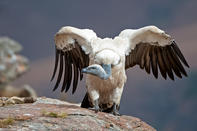
Name
Cape vulture (Gyps coprotheres) Also referred to as a Cape griffonAppearance
The Cape vulture is the heaviest of the Southern African vultures weighing in at up to 9 kgs and is mostly creamy dark brown in colour, with dark flight and tail feathers. The beak is black and the eye is amber. There is a patch of bare skin at the base of the neck that is thought to be a temperature sensor used to detect thermals. It has a wingspan of around 2.5 m.Cape Vulture Diet
The Cape vulture is a carrion feeder. It can consume up to 10% of its body weight in a single feeding.Cape Vulture Breeding
The Cape vulture breeds on cliff faces in large colonies. The female lays a single egg on a stick platform. The egg is incubated by both parents and the chick is fledged at around 140 days. The survival rate of chicks is very low with only around 20% making it until adulthood.Cape Vulture Behaviour
The Cape vulture is the highest flying of the Southern African vultures and has been recorded flying at 8000 m. Whilst soaring and searching for carrion at this height, the Cape vulture has eyesight that is estimated to be 20 times better than a human. They often feed in large groups. The Cape vulture can often be seen at a water source cleaning and preening itself.Threats
The Cape vulture is listed as endangered. The main threat is of them flying into overhead power lines and being electrocuted. Habitat reduction and a change in land use poses another threat to Cape vultures.
Plus poisoning, from eating carcasses of predators poisoned by farmers. They are also hunted for their body parts, for use in traditional medicine. There is an increase in bone abnormalities in chicks, which is believed to be from a calcium deficiency.